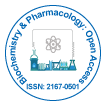
Biochemistry & Pharmacology: Open Access
Open Access
ISSN: 2167-0501

ISSN: 2167-0501
Opinion Article - (2025)Volume 14, Issue 1
The development of effective antiviral agents relies not only on their potency against viral targets but also on an in-depth understanding of their pharmacokinetic properties and bioavailability. These parameters dictate the Absorption, Distribution, Metabolism and Excretion (ADME) of a drug, ultimately determining its efficacy in vivo. As viruses continue to evolve and cause significant global health challenges as seen in the case of SARS-CoV-2, hepatitis viruses and HIV the design and evaluation of novel antiviral compounds has become a critical focus in pharmaceutical research. Pharmacokinetic studies provide the necessary bridge between the promising results observed in vitro and the practical realities of achieving therapeutic levels in the human body.
Bioavailability, defined as the fraction of an administered dose that reaches systemic circulation in an active form, is particularly crucial for oral antiviral drugs. Many promising antiviral compounds exhibit poor oral bioavailability due to factors such as low solubility, enzymatic degradation in the gastrointestinal tract, or significant first-pass metabolism in the liver. To address these limitations, novel formulation strategies such as nanoparticle carriers, lipid-based systems and prodrugs have been employed. These delivery systems aim to enhance membrane permeability and stability, thereby improving the concentration of the drug available at the target site.
Pharmacokinetic profiling involves a systematic evaluation of drug concentration over time across various biological compartments. Key parameters such as maximum plasma concentration, time to reach maximum concentration, half-life, area under the curve and clearance rate are measured following drug administration. These metrics help optimize dosing regimens, minimize toxicity and ensure sustained antiviral activity. For instance, an antiviral compound with a short half-life may require frequent dosing or a sustained-release formulation to maintain therapeutic plasma levels. In contrast, a long half-life may allow for once-daily or even less frequent dosing, improving patient compliance.
In the context of antiviral research, animal models such as mice, rats and non-human primates are typically used in early pharmacokinetic testing. These studies are followed by in vitro assays using human liver microsomes or recombinant enzymes to predict metabolic pathways and potential drug-drug interactions. Cytochrome P450 enzymes, particularly CYP3A4, play a central role in metabolizing many antiviral agents. Inhibitors or inducers of these enzymes can alter the pharmacokinetics of co-administered drugs, leading to subtherapeutic effects or increased toxicity. Therefore, understanding the enzyme interaction profile of a new antiviral compound is essential during the development phase.
In recent years, the use of physiologically based pharmacokinetic modeling has enhanced our ability to simulate drug behavior in virtual human populations. These computational models integrate physiological, biochemical and drug-specific data to predict systemic exposure, tissue distribution and interindividual variability. PBPK models have proven particularly valuable in evaluating the pharmacokinetics of antiviral agents in special populations such as pediatric, elderly and patients with hepatic or renal impairment. This approach supports the design of safer and more effective dosing strategies and can reduce the need for extensive in vivo trials.
Another important consideration is the role of transporter proteins such as P-glycoprotein (P-gp) and organic anion transporting polypeptides, which influence drug absorption and efflux. Many antiviral compounds are substrates of these transporters and their expression in the intestinal epithelium, liver and kidney can significantly affect bioavailability and systemic clearance. Co-administration of transporter inhibitors or formulation adjustments may be necessary to mitigate these effects and improve therapeutic performance.
Moreover, the development of antiviral agents often involves the creation of prodrugs molecules that undergo enzymatic or chemical conversion into the active drug form within the body. This strategy can improve solubility, enhance membrane permeability and circumvent first-pass metabolism. A classic example is tenofovir disoproxil fumarate, a prodrug of tenofovir, which demonstrates markedly improved oral bioavailability compared to its parent compound. Prodrug design, however, requires careful consideration of activation kinetics, enzyme specificity and potential by-products that may contribute to toxicity.
In conclusion, the pharmacokinetic evaluation and bioavailability profiling of novel antiviral compounds are essential components in the translation of bench-side discoveries into clinical success. Understanding the complex interactions between drug properties, biological systems and delivery mechanisms enables the development of antivirals that are not only potent but also practical for real-world use. Continued advancements in modeling techniques, drug delivery technologies and analytical tools will further enhance our ability to design and evaluate next-generation antiviral therapies that meet the demands of global public health challenges.
Citation: Jensen KM (2025). Pharmacokinetic Evaluation and Bioavailability Profiling of Novel Antiviral Compounds. Biochem Pharmacol.14:386.
Received: 03-Feb-2025, Manuscript No. BCPC-25-37580 ; Editor assigned: 05-Feb-2025, Pre QC No. BCPC-25-37580 (PQ); Reviewed: 19-Feb-2025, QC No. BCPC-25-37580 ; Revised: 26-Feb-2025, Manuscript No. BCPC-25-37580 (R); Published: 04-Mar-2025 , DOI: 10.35248/2167-0501.25.14.386
Copyright: © 2025 Jensen KM. This is an open-accessarticle distributed under the terms of the Creative Commons Attribution License, which permits unrestricted use, distribution, and reproduction in any medium, provided the original author and source are credited.